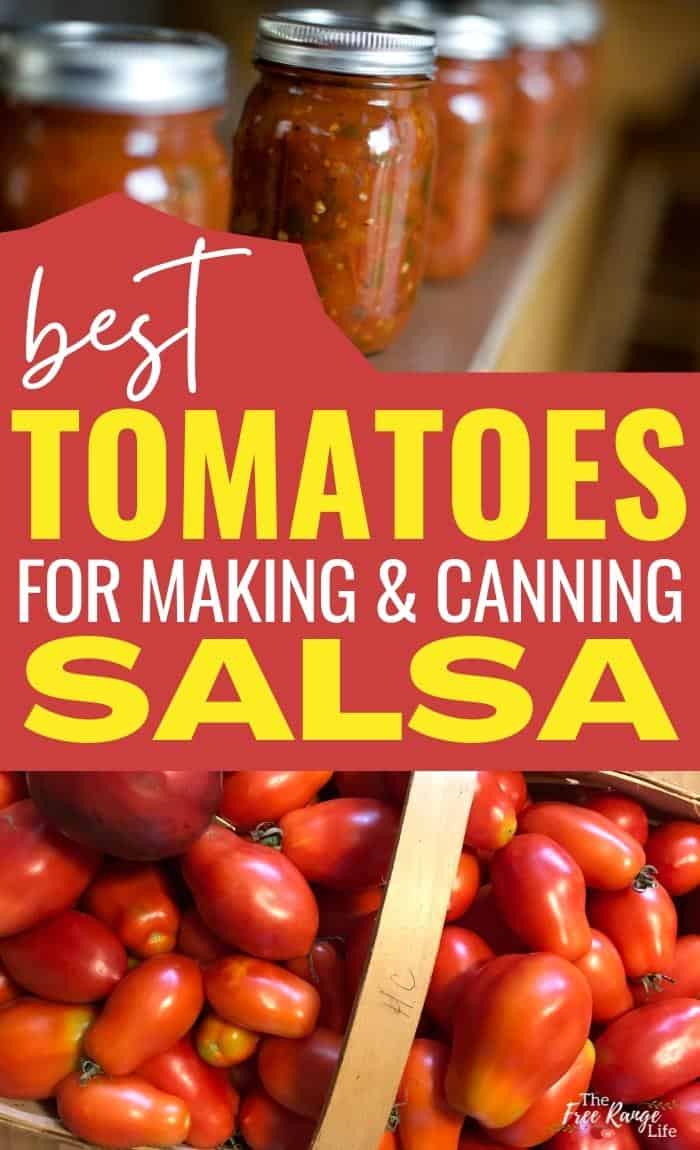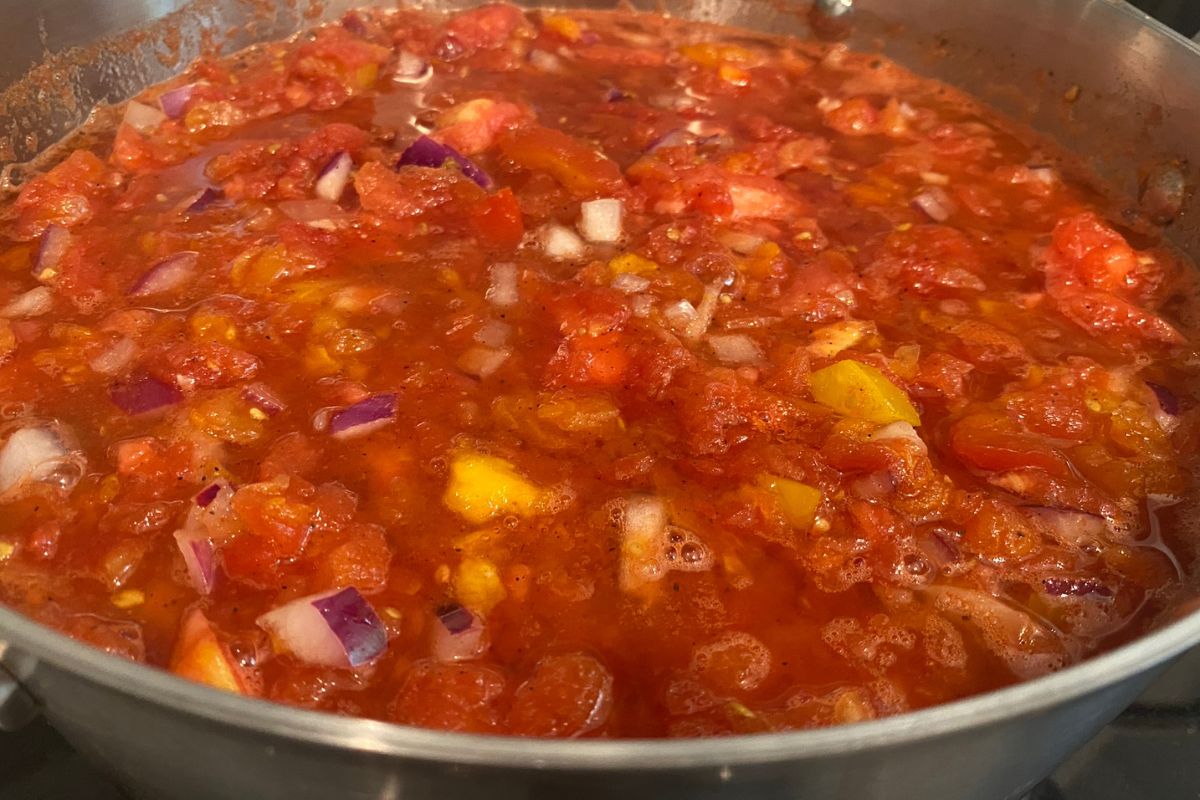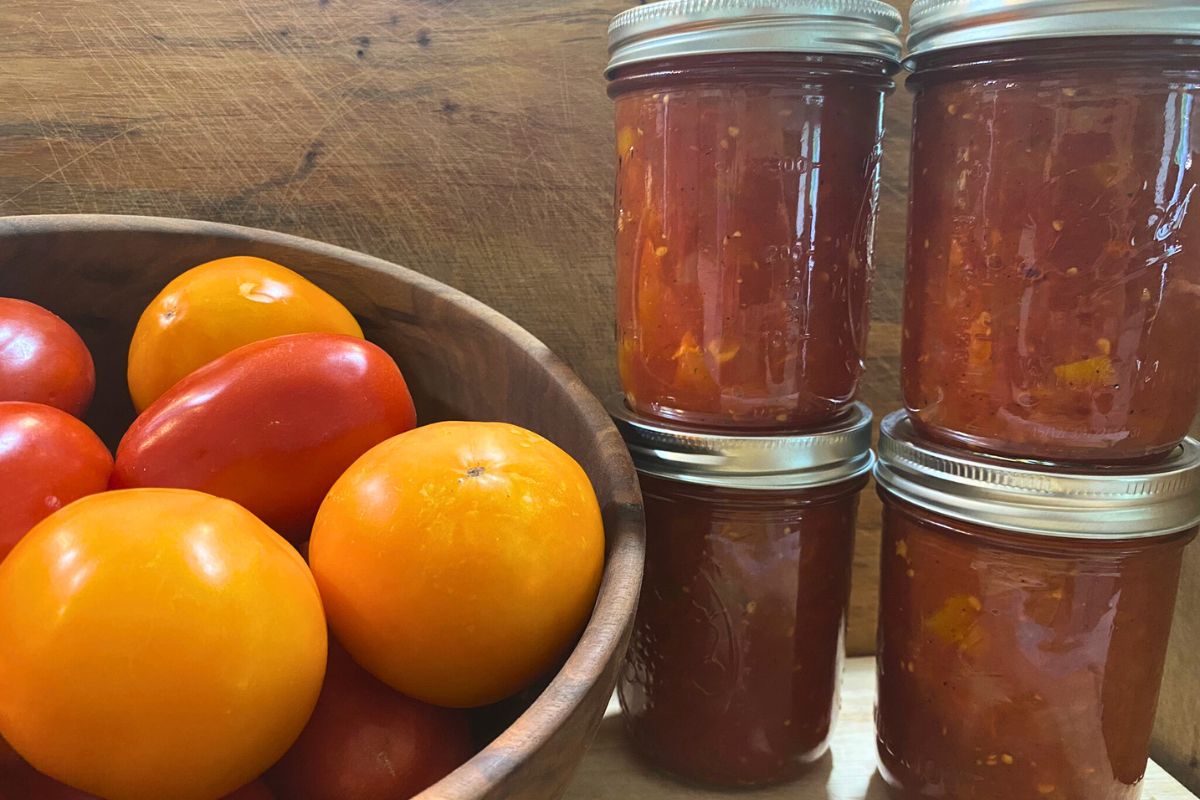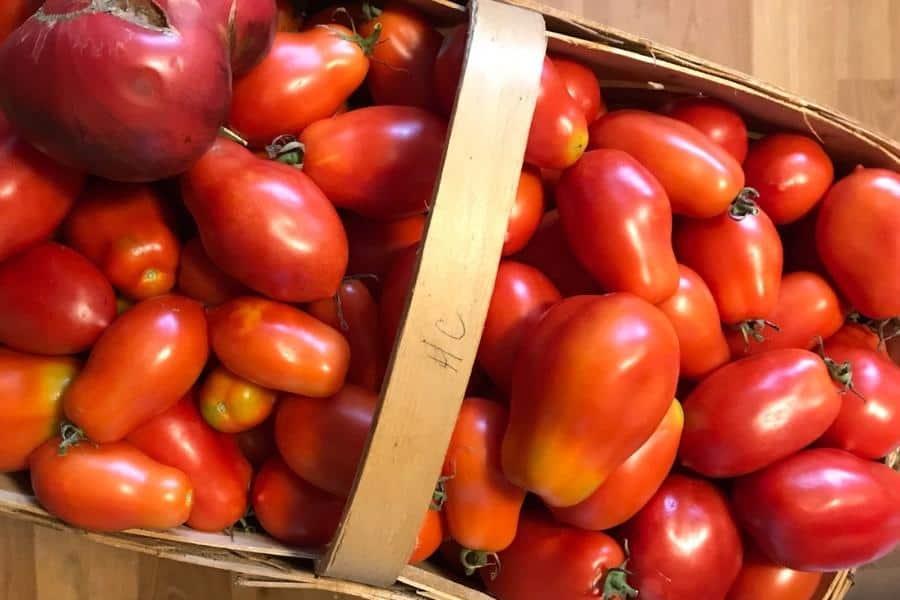Home canning salsa is an easy process to do using a water bath canner. But you may be wondering- what are the best tomatoes for salsa canning? Are there specific types of tomatoes you should be using in your home canned salsa or does it really matter?
Salsa is made by mixing tomatoes, onions, peppers, and spices. Because tomatoes are an acidic fruit, they can be processed and canned in a boiling water bath canner safely.
This site contains affiliate links. If you make a purchase using one of these links, I may earn a commission. Please see my disclosure page for more information about cookies collected and our privacy policy.
New to canning salsa at home? Here are some tips for success and choosing the best tomatoes for salsa canning.
The Best Tomatoes for Canning Salsa at Home
Before we talk about what types of tomatoes work best in home canned salsa, let’s talk about the some of the different types of tomatoes in general.
Paste Tomatoes: Also called plum tomatoes, these tomatoes have thick fruit walls and smaller seed cavities. They have a lower moisture content and are less seedy. Paste tomato skin is also thinner than other tomato types.
Slicing Tomatoes: Larger, round tomatoes that are perfect for slicing and placing on a sandwich or burger. They have thinner walls and more seeds.
Beefsteak Tomatoes: These tomatoes, as their name suggests, are big and juicy. They have a mild flavor and thick flesh. They are a larger slicing tomato that also has a high water content.
Cherry Tomatoes: These are small, juicy fruits that grow in clusters. Usually used for fresh eating and snacking, but also for drying. (Got lots of cherry tomatoes? Here’s how to preserve them: 5 Ways to Preserve Cherry Tomatoes)
Grape Tomatoes: These are even smaller than most cherry tomatoes. They usually contain less water and are perfect for fresh eating.
Remember that the type of tomato you use in your home canned salsa, will affect the quality of the salsa.
The best tomatoes for making and canning salsa is paste (or plum) tomatoes.
Because paste tomatoes have firmer flesh, thicker walls, and less water the resulting salsa will be thicker and more flavorful.
In reality, you can use any type of tomato for salsa canning. The type of tomato doesn’t affect the safety of the final canned salsa.
But the type of tomato you use will affect the texture, thickness, and flavor of the salsa.
For example, if you make salsa using a slicing tomato, the result will be thinner and more watery.
You can fix this by adding tomato paste, tomato powder, or by draining off some of the juice.
How to Choose the Right Tomatoes for Canning Salsa
What’s more important when choosing the right tomatoes for salsa canning, is the quality of the tomatoes.
When making salsa, you should choose tomatoes that are:
- Firm and a the peak of ripeness
- Free of damage such as bruises, cracks, blossom end rot, mold, or insect damage.
- Free of disease
This means choose high quality fruits. Don’t make salsa out of overripe tomatoes or damaged tomatoes.
You can mix and match tomato varieties and colors in your salsas- so don’t feel like you have to stick to just one type.
I actually encourage you to add in different varieties because this adds different layers of flavor to your finishes salsa!
My Favorite Tomato Varieties for Salsa
So, now that we’ve established that plum or paste tomatoes are best for salsa. Here are some of my favorite varieties:
Amish Paste: One of the most well known paste tomatoes for canning, and for good reason! These are some of the largest paste tomatoes with very meaty fruits.
Hungarian Paste: This determinate, pear-shaped paste tomato give clusters of 3-4 oz fruits. It’s highly productive and makes an excellent flavored salsa.
Tomato Roma: This old standby is the standard Italian canning and paste tomato. It has 3in long, pear-shaped fruits with thick walls and few seeds.
San Marzano: This Italian paste tomato has thick flesh, is nearly seedless, and very easy to peel. It’s also got a unique flavor that’s perfect for salsa.
Speckled Roman: This indeterminate paste tomato grows elongated tomatoes that average 6-8 oz. It has meaty flesh and little juice, make it perfect for sauce and salsa.
Costoluto Florentino/Genovese: While this is not a paste tomato, this Italian sauce tomato is deeply ribbed with amazing flavor that’s perfect for sauce and salsa.
Salsa Canning FAQ:
Can you use cherry tomatoes to make salsa?
Yes! While paste tomatoes produce the thickest salsa, you can you any tomatoes you have on hand to make homemade salsa- including cherry tomatoes.
Can you use slicing tomatoes for salsa canning?
Yes, you can use slicing tomatoes for salsa. Your salsa may end up more watery when using slicing tomatoes, but it can be fixed by draining some of the water, or adding tomato paste.
Do I have to cook salsa before canning?
No, salsa does not have to be cooked before canning. You can do a cold pack or hot pack when canning salsa.
Does salsa need to be pressure canned?
No, salsa is considered a high acid food which means it can be water bath canned. You do need to use a tested recipe that has the correct ratio of tomatoes, peppers, onions, and acidifier to make sure it can be canned safely.
Is it safe to can salsa in a water bath?
Yes, salsa can be canned in a water bath. Be aware that you need to use a tested recipe that has the correct ratio of tomatoes, peppers, onions, and acidifier to make sure it can be canned safely.
How do I thicken homemade salsa for canning?
If your salsa is too watery for your tastes you can thicken it by draining some of the water off. You can also add tomato paste or dried tomato powder to thicken your salsa. Do NOT add anything like cornstarch or flour to thicken your salsa.
Can I use green tomatoes or tomatillos for salsa?
Yes, you can substitute green tomatoes or tomatillos for red tomatoes in salsa.
Do you have to put vinegar in canned salsa?
Not necessarily, but you do need to add an acidifier of some sort. The acidity levels of tomatoes vary greatly, so you need to add acid to safely can salsa.
You can add commercially bottled lime or lemon juice or vinegar. Make sure the acidity is 5% in all of these. It’s best to follow the recipe directions for the addition of the acid.
Do I have to can salsa?
No, you can preserve salsa in other ways. I have kept salsa in the fridge for up to 6 weeks and you can freeze it for up to a year. Be warned that freezing will soften the salsa and change the texture a bit.
Looking for some recipes? Check these out:
How to Make Fresh Roasted Tomato Salsa
25 Homemade Salsa Recipes You Have to Try Today!







